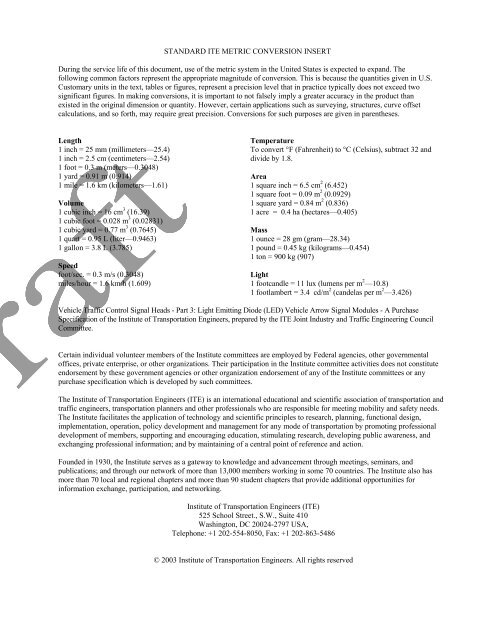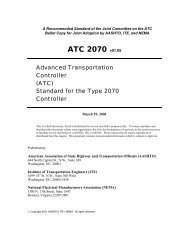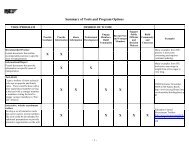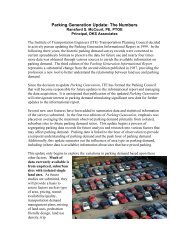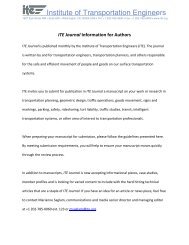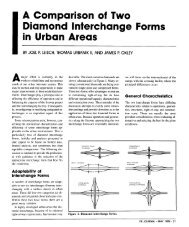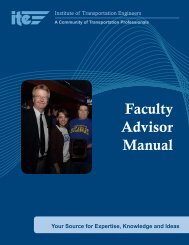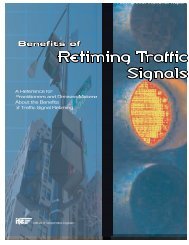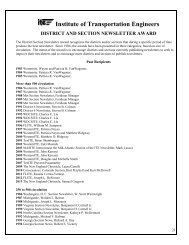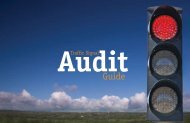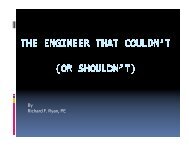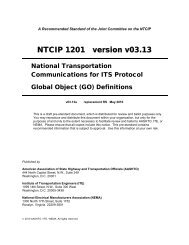Vehicle Traffic Control Signal Heads - Part 3 - Institute of ...
Vehicle Traffic Control Signal Heads - Part 3 - Institute of ...
Vehicle Traffic Control Signal Heads - Part 3 - Institute of ...
You also want an ePaper? Increase the reach of your titles
YUMPU automatically turns print PDFs into web optimized ePapers that Google loves.
STANDARD ITE METRIC CONVERSION INSERT<br />
During the service life <strong>of</strong> this document, use <strong>of</strong> the metric system in the United States is expected to expand. The<br />
following common factors represent the appropriate magnitude <strong>of</strong> conversion. This is because the quantities given in U.S.<br />
Customary units in the text, tables or figures, represent a precision level that in practice typically does not exceed two<br />
significant figures. In making conversions, it is important to not falsely imply a greater accuracy in the product than<br />
existed in the original dimension or quantity. However, certain applications such as surveying, structures, curve <strong>of</strong>fset<br />
calculations, and so forth, may require great precision. Conversions for such purposes are given in parentheses.<br />
Length<br />
1 inch = 25 mm (millimeters—25.4)<br />
1 inch = 2.5 cm (centimeters—2.54)<br />
1 foot = 0.3 m (meters—0.3048)<br />
1 yard = 0.91 m (0.914)<br />
1 mile = 1.6 km (kilometers—1.61)<br />
Volume<br />
1 cubic inch = 16 cm 3 (16.39)<br />
1 cubic foot = 0.028 m 3 (0.02831)<br />
1 cubic yard = 0.77 m 3 (0.7645)<br />
1 quart = 0.95 L (liter—0.9463)<br />
1 gallon = 3.8 L (3.785)<br />
Speed<br />
foot/sec. = 0.3 m/s (0.3048)<br />
miles/hour = 1.6 km/h (1.609)<br />
Temperature<br />
To convert °F (Fahrenheit) to °C (Celsius), subtract 32 and<br />
divide by 1.8.<br />
Area<br />
1 square inch = 6.5 cm 2 (6.452)<br />
1 square foot = 0.09 m 2 (0.0929)<br />
1 square yard = 0.84 m 2 (0.836)<br />
1 acre = 0.4 ha (hectares—0.405)<br />
Mass<br />
1 ounce = 28 gm (gram—28.34)<br />
1 pound = 0.45 kg (kilograms—0.454)<br />
1 ton = 900 kg (907)<br />
Light<br />
1 footcandle = 11 lux (lumens per m 2 —10.8)<br />
1 footlambert = 3.4 cd/m 2 (candelas per m 2 —3.426)<br />
<strong>Vehicle</strong> <strong>Traffic</strong> <strong>Control</strong> <strong>Signal</strong> <strong>Heads</strong> - <strong>Part</strong> 3: Light Emitting Diode (LED) <strong>Vehicle</strong> Arrow <strong>Signal</strong> Modules - A Purchase<br />
Specification <strong>of</strong> the <strong>Institute</strong> <strong>of</strong> Transportation Engineers, prepared by the ITE Joint Industry and <strong>Traffic</strong> Engineering Council<br />
Committee.<br />
Certain individual volunteer members <strong>of</strong> the <strong>Institute</strong> committees are employed by Federal agencies, other governmental<br />
<strong>of</strong>fices, private enterprise, or other organizations. Their participation in the <strong>Institute</strong> committee activities does not constitute<br />
endorsement by these government agencies or other organization endorsement <strong>of</strong> any <strong>of</strong> the <strong>Institute</strong> committees or any<br />
purchase specification which is developed by such committees.<br />
The <strong>Institute</strong> <strong>of</strong> Transportation Engineers (ITE) is an international educational and scientific association <strong>of</strong> transportation and<br />
traffic engineers, transportation planners and other pr<strong>of</strong>essionals who are responsible for meeting mobility and safety needs.<br />
The <strong>Institute</strong> facilitates the application <strong>of</strong> technology and scientific principles to research, planning, functional design,<br />
implementation, operation, policy development and management for any mode <strong>of</strong> transportation by promoting pr<strong>of</strong>essional<br />
development <strong>of</strong> members, supporting and encouraging education, stimulating research, developing public awareness, and<br />
exchanging pr<strong>of</strong>essional information; and by maintaining <strong>of</strong> a central point <strong>of</strong> reference and action.<br />
Founded in 1930, the <strong>Institute</strong> serves as a gateway to knowledge and advancement through meetings, seminars, and<br />
publications; and through our network <strong>of</strong> more than 13,000 members working in some 70 countries. The <strong>Institute</strong> also has<br />
more than 70 local and regional chapters and more than 90 student chapters that provide additional opportunities for<br />
information exchange, participation, and networking.<br />
<strong>Institute</strong> <strong>of</strong> Transportation Engineers (ITE)<br />
525 School Street., S.W., Suite 410<br />
Washington, DC 20024-2797 USA,<br />
Telephone: +1 202-554-8050, Fax: +1 202-863-5486<br />
© 2003 <strong>Institute</strong> <strong>of</strong> Transportation Engineers. All rights reserved


